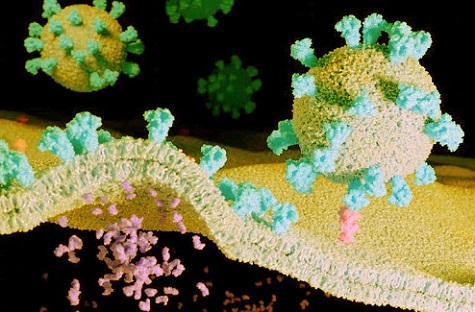Nikhil Prasad Fact checked by:Thailand Medical News Team Jul 15, 2024 1 year, 5 months, 5 days, 11 hours, 48 minutes ago
Medical News: A groundbreaking study from a team of researchers at Henan University of Science and Technology-China delves into the critical role of tripartite motif (TRIM) proteins in the body’s defense against respiratory viruses like the influenza A virus (IAV) and respiratory coronaviruses (CoVs). These viruses have posed significant threats to public health, causing widespread illness and fatalities. This
Medical News report explores the fascinating discoveries and potential implications of this research in the ongoing battle against viral infections.
 TRIM proteins can defend against Influenza viruses and Coronaviruses
What are TRIM Proteins?
TRIM proteins can defend against Influenza viruses and Coronaviruses
What are TRIM Proteins?
TRIM proteins are a family of proteins characterized by a conserved N-terminal RBCC motif, which includes a RING domain, one or two B-box domains, and a coiled-coil domain. Found widely across various species, including humans, animals, and even insects, these proteins play diverse roles in cellular processes such as development, differentiation, oncogenesis, apoptosis, and antiviral immunity.
The Focus on Influenza A Virus
The influenza A virus is notorious for its ability to mutate and cause global pandemics. Its surface proteins, hemagglutinin (HA) and neuraminidase (NA), are crucial for its identification and infection mechanisms. The IAV is known for its high variability, making it a challenging target for vaccines and antiviral drugs. This is where TRIM proteins come into play as a promising area of research for new antiviral strategies.
TRIM Proteins and Influenza A Virus
Recent studies have highlighted the significant role of TRIM proteins in inhibiting the influenza A virus. TRIM14, TRIM22, and TRIM41 are among the TRIM proteins that have shown effectiveness in targeting and degrading viral components essential for the virus's replication. For instance, TRIM14 interacts with the viral nucleoprotein (NP) and facilitates its degradation, thereby hindering the formation of viral ribonucleoprotein complexes necessary for viral replication.
Similarly, TRIM22 has been identified as a potent inhibitor of IAV replication. This protein can induce the polyubiquitination and proteasomal degradation of NP, preventing the virus from replicating in human cells. Interestingly, TRIM22 is expressed constitutively in some primary cells, providing a pre-existing defense mechanism against IAV infection.
TRIM41 and Its Role in Influenza Defense
Another crucial TRIM protein, TRIM41, targets the NP for proteasomal destruction. Studies have shown that overexpression of TRIM41 reduces host susceptibility to IAV infection, whereas knocking out TRIM41 facilitates viral infection. This finding underscores the potential of TRIM41 as a target for antiviral therapies.
TRIM Proteins in Respiratory Coronavirus Defense
The study also sheds light on the role of TRIM proteins in combating respiratory coronaviruses, including SARS-CoV-2, the virus resp
onsible for the COVID-19 pandemic. TRIM21 and TRIM22 are notable for their ability to interact with and degrade viral components. For example, TRIM21 targets the nucleocapsid protein (NP) of SARS-CoV-2, leading to its degradation and subsequently hindering viral particle assembly.
TRIM22 and SARS-CoV-2
TRIM22, induced upon SARS-CoV-2 infection, targets the non-structural protein 8 (NSP8), a subunit promoting the activity of the virus's RNA-dependent RNA polymerase. By promoting the proteasomal degradation of NSP8, TRIM22 effectively inhibits the virus's replication process.
Diverse Mechanisms of TRIM56
TRIM56 has shown a broad spectrum of antiviral activity against various viruses, including influenza virus, human coronavirus OC43, yellow fever virus (YFV), and dengue virus serotype 2 (DENV2). Unlike other TRIM proteins, TRIM56's antiviral mechanisms vary depending on the virus it targets. For influenza viruses, TRIM56 impedes viral RNA synthesis, whereas it interferes at later stages of the HCoV-OC43 life cycle.
The Dual Role of TRIM28
Interestingly, TRIM28 demonstrates a dual role in regulating coronavirus infections. On one hand, it can enhance SARS-CoV-2 virulence through SUMOylation of the NP, which facilitates immunosuppression. On the other hand, TRIM28 can regulate ACE2 expression, the receptor SARS-CoV-2 uses to enter host cells, thereby influencing the virus's ability to infect cells.
Future Directions and Implications
Understanding the multifaceted roles of TRIM proteins in antiviral defense opens new avenues for developing targeted antiviral therapies. The ability of TRIM proteins to directly target viral components or modulate host immune responses highlights their potential as therapeutic targets.
However, the multifunctional nature of TRIM proteins presents a challenge for clinical applications. Different TRIM proteins may inhibit specific viruses or viral strains, and some TRIM proteins may have more than one antiviral action. For instance, TRIM25 has been shown to destabilize IAV mRNAs and inhibit viral replication, demonstrating its potential as a broad-spectrum antiviral protein.
Conclusion
The study findings provide valuable insights into the role of TRIM proteins in defending against respiratory viruses. These findings underscore the importance of continuing to explore virus-host interactions to identify novel antiviral targets.
The study findings were published in the peer-reviewed journal: Frontiers in Cellular and Infection Microbiology.
https://www.frontiersin.org/journals/cellular-and-infection-microbiology/articles/10.3389/fcimb.2024.1420854/full
Thailand
Medical News is currently working with teams of researchers in Munich, Osaka, Sao Paulo and Poland to identify phytochemicals that can help upregulate the expression of 7 different TRIM proteins that can serve as prophylactics against influenza or coronavirus infections.
For the latest on Influenza viruses and coronaviruses, keep on logging to Thailand
Medical News.
Read Also:
https://www.thailandmedical.news/news/covid-19-news:-e3-ligase-trim22-inhibits-sars-cov-2-by-proteasomal-degradation-of-nsp8
https://www.thailandmedical.news/news/breaking-covid-19-news-sars-cov-2-orf3a-protein-damages-renal-tubules-via-trim59-induced-stat3-activation-causing-acute-kidney-injury
